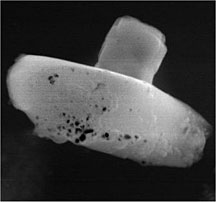- Number 290 |
- July 6, 2009
Lead in clouds: A bad news/good news scenario

Lead shows as black dots in a
scanning
electron image of
ice-crystal residual
particles
from clouds collected in the
Swiss Alps. Lead from human
activities
may influence climate
through cloud
formation.
By sampling clouds and making their own, an international team has shown for the first time that lead from the use of fossil fuels is changing the properties of clouds and, therefore, the way the sun's energy affects the atmosphere. The results from the study led by Dan Cziczo at DOE’s Pacific Northwest National Laboratory suggest a bad news-good news scenario. The lead causes clouds to form at warmer temperatures and with less water, which could change rainfall patterns and reduce snowpack. On the other hand, lead-laden clouds send more heat from the earth back into space, cooling the world slightly and possibly lessening global warming. The results appeared in Nature Geoscience, a new journal in the prestigious Nature series.
[Kristin Manke, 509.372.6011,
kristin.manke@pnl.gov]
